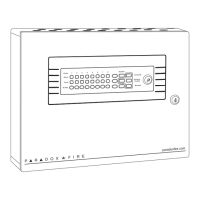2.3 Additional system fault indications
In this group three distinct fault conditions are indicated:
2.3.1 SIGNALING DEVICE fault
When active, this indicator signies a fault condition of the signaling device output. The
fault can be one of the following:
Short circuit of the two output wires•
Open circuit in the connecting cable between the block connector and the signaling •
device. The signaling device must be terminated with a 4.7K Ohm resistor (EOL)
Blown fuse that protects the system from shorts while the signalling device is in •
operation.
2.3.2 EARTH fault
When active, this indicator signies a short circuit between any of the panel’s wiring
(zones, relays, outputs etc.) and the building’s earth is detected.
The signaling device output wires are also monitored for the earth short condition.
2.3.3 AUX POWER Fault
When active, this indicator signies an overcurrent condition at the auxiliary power out-
put is detected. The maximum allowed current is 1 Amp. The device is capable of con-
tinuous operation even at full short circuit of this output; though any device powered from
this output will stop functioning.
If more than 1 Amp is required, a compatible EN 54-4 approved re alarm power supply
must be used. When such a power supply is used, the -24 OUT connection of the panel
must be connected to the negative terminal of the auxiliary power supply.
2.4 Zone Fault indications
The Zone Fault indications will blink, in a different pattern, (Figure 2, page 6) depending
on the type of the problem that occurs.
In detail:
(a) If a short-circuit or an opening of a zone is detected, System FAULT indication will
turn ON, the corresponding Zones FAULT indication will blink as in Pattern A, (Figure 2,
page 6) and at the same time there will be an audible notication from the on board
Buzzer.
Possible causes of a zone problem are:
(a1) Disconnection or interruption of wiring of the zone.
(a2) Short-circuit in the wiring of the zone.
(a3) Removal of sensor from its base.
(a4) Removal of the terminating resistor (EOL).
(b) When a Relay expansion module is used the Zones FAULT indication is also trig-
gered by:
A short-circuit or opening of the wiring in the corresponding zone relay output.•
Removal of the output terminating resistor (EOL).•
In case (b) as listed above the System FAULT indication will turn ON and the Zones
FAULT indication of the corresponding zone will blink (Figure 2, Pattern b). At the same
time there is also an audible notication from the on board Buzzer.

